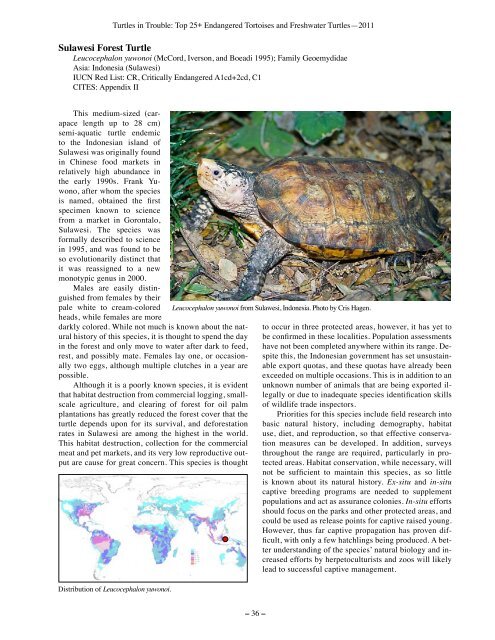Turtles in Trouble: The World's 25+ Most Endangered - Wildlife ...
Turtles in Trouble: The World's 25+ Most Endangered - Wildlife ...
Turtles in Trouble: The World's 25+ Most Endangered - Wildlife ...
- No tags were found...
You also want an ePaper? Increase the reach of your titles
YUMPU automatically turns print PDFs into web optimized ePapers that Google loves.
<strong>Turtles</strong> <strong>in</strong> <strong>Trouble</strong>: Top <strong>25+</strong> <strong>Endangered</strong> Tortoises and Freshwater <strong>Turtles</strong>—2011Sulawesi Forest TurtleLeucocephalon yuwonoi (McCord, Iverson, and Boeadi 1995); Family GeoemydidaeAsia: Indonesia (Sulawesi)IUCN Red List: CR, Critically <strong>Endangered</strong> A1cd+2cd, C1CITES: Appendix IIThis medium-sized (carapacelength up to 28 cm)semi-aquatic turtle endemicto the Indonesian island ofSulawesi was orig<strong>in</strong>ally found<strong>in</strong> Ch<strong>in</strong>ese food markets <strong>in</strong>relatively high abundance <strong>in</strong>the early 1990s. Frank Yuwono,after whom the speciesis named, obta<strong>in</strong>ed the firstspecimen known to sciencefrom a market <strong>in</strong> Gorontalo,Sulawesi. <strong>The</strong> species wasformally described to science<strong>in</strong> 1995, and was found to beso evolutionarily dist<strong>in</strong>ct thatit was reassigned to a newmonotypic genus <strong>in</strong> 2000.Males are easily dist<strong>in</strong>guishedfrom females by theirpale white to cream-coloredheads, while females are moredarkly colored. While not much is known about the naturalhistory of this species, it is thought to spend the day<strong>in</strong> the forest and only move to water after dark to feed,rest, and possibly mate. Females lay one, or occasionallytwo eggs, although multiple clutches <strong>in</strong> a year arepossible.Although it is a poorly known species, it is evidentthat habitat destruction from commercial logg<strong>in</strong>g, smallscaleagriculture, and clear<strong>in</strong>g of forest for oil palmplantations has greatly reduced the forest cover that theturtle depends upon for its survival, and deforestationrates <strong>in</strong> Sulawesi are among the highest <strong>in</strong> the world.This habitat destruction, collection for the commercialmeat and pet markets, and its very low reproductive outputare cause for great concern. This species is thoughtDistribution of Leucocephalon yuwonoi.Leucocephalon yuwonoi from Sulawesi, Indonesia. Photo by Cris Hagen.to occur <strong>in</strong> three protected areas, however, it has yet tobe confirmed <strong>in</strong> these localities. Population assessmentshave not been completed anywhere with<strong>in</strong> its range. Despitethis, the Indonesian government has set unsusta<strong>in</strong>ableexport quotas, and these quotas have already beenexceeded on multiple occasions. This is <strong>in</strong> addition to anunknown number of animals that are be<strong>in</strong>g exported illegallyor due to <strong>in</strong>adequate species identification skillsof wildlife trade <strong>in</strong>spectors.Priorities for this species <strong>in</strong>clude field research <strong>in</strong>tobasic natural history, <strong>in</strong>clud<strong>in</strong>g demography, habitatuse, diet, and reproduction, so that effective conservationmeasures can be developed. In addition, surveysthroughout the range are required, particularly <strong>in</strong> protectedareas. Habitat conservation, while necessary, willnot be sufficient to ma<strong>in</strong>ta<strong>in</strong> this species, as so littleis known about its natural history. Ex-situ and <strong>in</strong>-situcaptive breed<strong>in</strong>g programs are needed to supplementpopulations and act as assurance colonies. In-situ effortsshould focus on the parks and other protected areas, andcould be used as release po<strong>in</strong>ts for captive raised young.However, thus far captive propagation has proven difficult,with only a few hatchl<strong>in</strong>gs be<strong>in</strong>g produced. A betterunderstand<strong>in</strong>g of the species’ natural biology and <strong>in</strong>creasedefforts by herpetoculturists and zoos will likelylead to successful captive management.– 36 –







![RaLand / SeaScape [PDF] - Wildlife Conservation Society](https://img.yumpu.com/49974326/1/190x245/raland-seascape-pdf-wildlife-conservation-society.jpg?quality=85)








